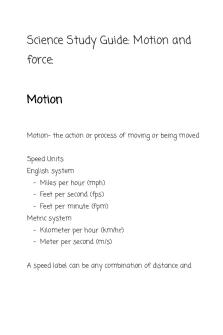Study guide - Bios notes PDF

| Title | Study guide - Bios notes |
|---|---|
| Course | Anatomy & Physiology III With Lab |
| Institution | Chamberlain University |
| Pages | 7 |
| File Size | 587.6 KB |
| File Type | |
| Total Downloads | 20 |
| Total Views | 169 |
Summary
Bios notes...
Description
A&P Study Guide Cardio System
The pericardium consists of an outer fibrous pericardium and an inner serous pericardium The serous pericardium has 2 layers: 1. Visceral 2. Parietal The visceral and parietal layers are separated by the serous cavity, a fluid-filled space
The wall of the heart has 3 layers: 1. Epicardium 2. Myocardium 3.Endocardium
baby has this
NEXT TO #1 IS FOSSA=indentation
EXERCISE Regular aerobic exercise can: •
Increase cardiac output
•
Increase HDL
•
Decrease triglycerides
•
Improve lung function
•
Decrease blood pressure
Assist in weight control
Flow of heart BODY 1.Vena Cava or Coronary Sinus 2. RA 3. Tricuspid 4. RV 5. Pulmonary (Semi Lunar) 6. Pulmonary Trunk LUNGSSSS 7. Pulmonary Veins 8. LA 9. Bicuspid (Mitral) 10. LV 11. Aortic (Semi Lunar) 12. Aorta Right of the heart= coming from body Left of the heart= lungs/back to body Coronary sinus- Carries blood around the heart. Inside the right atrium. Gathering blood from all around heart for recirculation.
Cardiac muscle cells are self-excitable, and therefore, autorhythmic, brains tell it what to do Cardiac muscle cells repeatedly generate spontaneous action potentials that then trigger heart contractions These cells form the conduction system, which is the route for propagating action potentials through the heart muscle The autorhythmic fibers in the SA node are the natural pacemaker of the heart because they initiate action potentials most frequently Signals from the nervous system and hormones (like epinephrine) can modify the heart rate and force of contraction but they do not set the fundamental rhythm
Sends signal to atria, then sends signal to AV node, (pacemaker as well with SA node), then send it to Bundle of His or AV bundle, branches off to left and right bundle, then to Purkinje fibers. then muscles coordinate Heart contraction Takes longer than skeletal muscle. Holds onto calcium and potassium. Potassium goes out calcium comes in, delaying the drop (repolarization) Bottom line: cardiac muscle has an obligated plateau because of K and Ca!!
Cardiac muscle generates ATP via anaerobic cellular respiration and creatine phosphate
EKG AND WIGGERS PWAVE- SA NODE triggers and electrical signals to atria (depolarization of the atria=RA) Between P WAVE=still an electrical signal (AV NODE) down bundle of his hits Purkinje fibers then hits the QRS wave QRS- in RV (P and QRS is depolarization) depolarization of the ventricle (change or shift) ST segement T wave- repolarization=reset of ventricles SYSTOLE=draw together or contract systolic blood pressure when it develops when heart (contract) Volume is going down where is it going? Part of it to body, part of it to lungs LV=body Contraction reaches limit and reaches a plateau.
Tachycardia=fast > 100 Bradycardia=slow...
Similar Free PDFs

Study guide - Bios notes
- 7 Pages

BIOS 2061 Lecture Notes
- 94 Pages

Bios
- 4 Pages

Study guide Apush - notes
- 18 Pages

Lecture Notes, Study Guide
- 6 Pages

questions/notes/ study guide
- 1 Pages

Science Study Guide - notes
- 14 Pages

Ch13 Notes - study guide
- 2 Pages

questions/notes/ study guide
- 3 Pages

Economics Study Guide Notes
- 5 Pages

Study Guide Notes
- 17 Pages

questions/notes/ study guide
- 3 Pages

questions/notes/ study guide
- 1 Pages

Nursing study guide - notes
- 46 Pages

Final Exam Notes/Study Guide
- 29 Pages
Popular Institutions
- Tinajero National High School - Annex
- Politeknik Caltex Riau
- Yokohama City University
- SGT University
- University of Al-Qadisiyah
- Divine Word College of Vigan
- Techniek College Rotterdam
- Universidade de Santiago
- Universiti Teknologi MARA Cawangan Johor Kampus Pasir Gudang
- Poltekkes Kemenkes Yogyakarta
- Baguio City National High School
- Colegio san marcos
- preparatoria uno
- Centro de Bachillerato Tecnológico Industrial y de Servicios No. 107
- Dalian Maritime University
- Quang Trung Secondary School
- Colegio Tecnológico en Informática
- Corporación Regional de Educación Superior
- Grupo CEDVA
- Dar Al Uloom University
- Centro de Estudios Preuniversitarios de la Universidad Nacional de Ingeniería
- 上智大学
- Aakash International School, Nuna Majara
- San Felipe Neri Catholic School
- Kang Chiao International School - New Taipei City
- Misamis Occidental National High School
- Institución Educativa Escuela Normal Juan Ladrilleros
- Kolehiyo ng Pantukan
- Batanes State College
- Instituto Continental
- Sekolah Menengah Kejuruan Kesehatan Kaltara (Tarakan)
- Colegio de La Inmaculada Concepcion - Cebu
